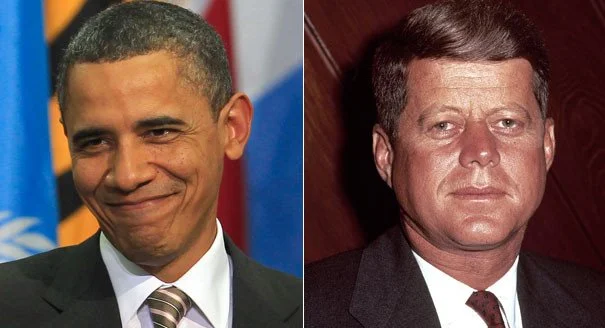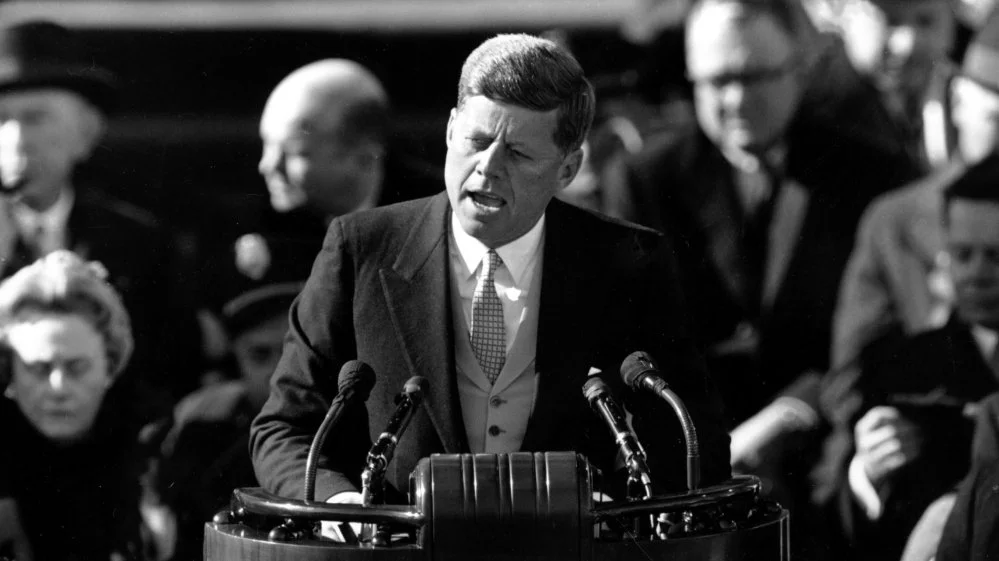Shaping America: The Differences of Two Revolutionary Presidents
Written by: Alaina Yan
Obama (left) and Kennedy (right)
Two powerful presidents, Obama and Kennedy, brought many “firsts” to American politics: Obama was the first African-American president, and Kennedy was the youngest president, age 43, to be elected into office. Their shared revolutionary characteristics carried over to their similar eloquence, both known for their empowering inaugural speeches. While both Kennedy and Obama shared similar goals for international peace and supporting developing countries, they differed in the methods to help those countries and their call for Americans to make change domestically.
To begin, both presidents use repetition of phrases to highlight their vision for America. In paragraph six to eight, Kennedy repeats the phrase “to those” when he states “To those old allies whose cultural and spiritual origins we share…” in paragraph 6. Paragraph 8 has a similar structure as Kennedy exclaims “To those people in the hurts and villages of half the globe struggling to break the bonds of mass misery…” By repeating the phrase “to those,” Kennedy directly displays his support for their fight for democracy and freedom. As America was in the Cold War during Kennedy’s presidency, Kennedy’s repetition underlines his vision for future world peace and a cease in international quarrel; rather than fight each other over different beliefs, they should respect and support each other. Obama does something similar in paragraphs 24 to 26 of his speech. Here, Obama opens each paragraph by addressing a certain audience with the word “to.” In paragraph 24 Obama declares “to those who cling to power through corruption, ….you are on the wrong side of history” and in paragraph 25 when Obama states “to the Muslim world, we seek a new way forward.” Similar to Kennedy, Obama addresses his diverse American audience to unite them and bring peace. As one of Obama’s key policies was to unite the, at the time, divided America, his repetition of “to” encourages the differing parties of people to put aside their differences and come together as one. Thus, both Kennedy and Obama use repetition to discuss their vision of a united and peaceful America.
Obama at his 2009 inaugural speech
Moreover, both Kennedy and Obama use juxtaposition to invoke and call their audiences to attention. In Kennedy’s speech, he declares, “Now the trumpet summons us again--not as a call to bear arms, though arms we need--not as a call to battle, though embattled we are–...” in paragraph 22. In paragraph 8, Obama similarly uses contrasting nouns together when he states how “On this day, we gather because we have chosen hope over fear, unity of purpose over conflict and discord.” Here, in both president’s speeches, they utilize directly contrasting nouns to emphasize their plans for the audience. Calling them to action to fight against corruption, the presidents use the contrasting diction to empower their audience; if they take action, the audience is embodying the “good” word rather than the negative one. Thus, through their shared usage of juxtaposition, both Kennedy and Obama kickstart their audience to take action.
Although Kennedy and Obama share many similarities, they also have a few differences. Throughout their speeches, Obama and Kennedy use different pronouns to establish their relationship with the audience. In Obama’s speech, he constantly uses the word “we” and other personal pronouns. This is especially prominent in paragraph 12 when he declares in paragraph 12 how “We remain the most prosperous powerful nation on Earth. Our workers are no less productive than when this crisis began. Our minds are no less inventive…” On the other hand, Kennedy utilizes the second-person pronouns “you” more often. In his most renowned line, Kennedy exclaims in paragraph 25, “And so, my fellow Americans: ask not what your country can do for you–ask what you can do for your country.” In contrast with Kennedy, Obama’s usage of “we” establishes himself as on the same level as his audience—he is one of them. Thus, when explaining his vision for the future, he implies that he will work alongside the people to execute the change. Kennedy’s usage of “you” and “I” creates a stark distinction between him and the audience. In doing so, Kennedy marks himself as the leader of his movement, guiding his American audience to making that change. Instead of working with them, all action is the people’s responsibility.
Kennedy delivering his famous line “ask now what your country can do for you, but what you can do for your country.”
Ultimately, Kennedy and Obama share many similarities and differences. While they both utilize juxtaposition and repetition to describe their vision for the future, they diverge from their descriptions on the steps to achieve the change. Despite this difference, Obama and Kennedy share many characteristics of optimism and charisma. Their confidence and demeanor enhanced their speeches into unforgettable pieces of American history, to which we still admire today.
Read speeches here (refer to paragraphs using these links)
*Note: We do not own the rights to these speeches. They are for educational purposes.
https://docs.google.com/document/d/1891ekUhO0dJ5vKVO5kQPiNY2ZGCJSoSXJaTrhebjouM/edit?usp=sharing


